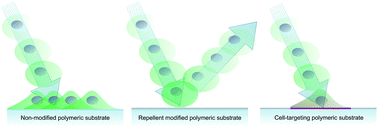Chemical approaches to synthetic polymer surface biofunctionalization for targeted cell adhesion using small binding motifs
Abstract
In the present review the principal strategies to chemically modify the surface of synthetic polymeric materials with small molecules for targeted cell adhesion are collated and critically discussed. The focus is purposely oriented on the chemistry involved in these modifications and neither the physical characterizations nor the activity evaluations resulting from these modifications are addressed in depth, although most reviewed examples demonstrate cell adhesion. Particularly, the introduction of a chemical anchor onto the polymeric substrate, the spacing via a linker between the polymer surface and the cell-binding motif, as well as the linkage generated on this cell-binding motif are discussed. Particular cases where variable substrate geometries or spatial patterning are achieved are additionally highlighted.


 Please wait while we load your content...
Please wait while we load your content...